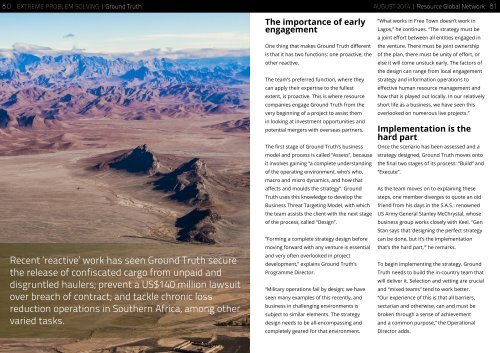Create successful ePaper yourself
Turn your PDF publications into a flip-book with our unique Google optimized e-Paper software.
80<br />
EXTREME PROBLEM SOLVING | Ground Truth<br />
AUGUST 2014 | Resource Global Network 81<br />
Recent ‘reactive’ work has seen Ground Truth secure<br />
the release of confiscated cargo from unpaid and<br />
disgruntled haulers; prevent a US$140 million lawsuit<br />
over breach of contract; and tackle chronic loss<br />
reduction operations in Southern Africa, among other<br />
varied tasks.<br />
The importance of early<br />
engagement<br />
One thing that makes Ground Truth different<br />
is that it has two functions: one proactive, the<br />
other reactive.<br />
The team’s preferred function, where they<br />
can apply their expertise to the fullest<br />
extent, is proactive. This is where resource<br />
companies engage Ground Truth from the<br />
very beginning of a project to assist them<br />
in looking at investment opportunities and<br />
potential mergers with overseas partners.<br />
The first stage of Ground Truth’s business<br />
model and process is called “Assess”, because<br />
it involves gaining “a complete understanding<br />
of the operating environment, who’s who,<br />
macro and micro dynamics, and how that<br />
affects and moulds the strategy”. Ground<br />
Truth uses this knowledge to develop the<br />
Business Threat Targeting Model, with which<br />
the team assists the client with the next stage<br />
of the process, called “Design”.<br />
“Forming a complete strategy design before<br />
moving forward with any venture is essential<br />
and very often overlooked in project<br />
development,” explains Ground Truth’s<br />
Programme Director.<br />
“Military operations fail by design; we have<br />
seen many examples of this recently, and<br />
business in challenging environments is<br />
subject to similar elements. The strategy<br />
design needs to be all-encompassing and<br />
completely geared for that environment.<br />
“What works in Free Town doesn’t work in<br />
Lagos,” he continues. “The strategy must be<br />
a joint effort between all entities engaged in<br />
the venture. There must be joint ownership<br />
of the plan, there must be unity of effort, or<br />
else it will come unstuck early. The factors of<br />
the design can range from local engagement<br />
strategy and information operations to<br />
effective human resource management and<br />
how that is played out locally. In our relatively<br />
short life as a business, we have seen this<br />
overlooked on numerous live projects.”<br />
Implementation is the<br />
hard part<br />
Once the scenario has been assessed and a<br />
strategy designed, Ground Truth moves onto<br />
the final two stages of its process: “Build” and<br />
“Execute”.<br />
As the team moves on to explaining these<br />
steps, one member diverges to quote an old<br />
friend from his days in the S.A.S.: renowned<br />
US Army General Stanley McChrystal, whose<br />
business group works closely with Keel. “Gen<br />
Stan says that ‘designing the perfect strategy<br />
can be done, but it’s the implementation<br />
that’s the hard part,’” he remarks.<br />
To begin implementing the strategy, Ground<br />
Truth needs to build the in-country team that<br />
will deliver it. Selection and vetting are crucial<br />
and “mixed teams” tend to work better.<br />
“Our experience of this is that all barriers,<br />
sectarian and otherwise, can and must be<br />
broken through a sense of achievement<br />
and a common purpose,” the Operational<br />
Director adds.


